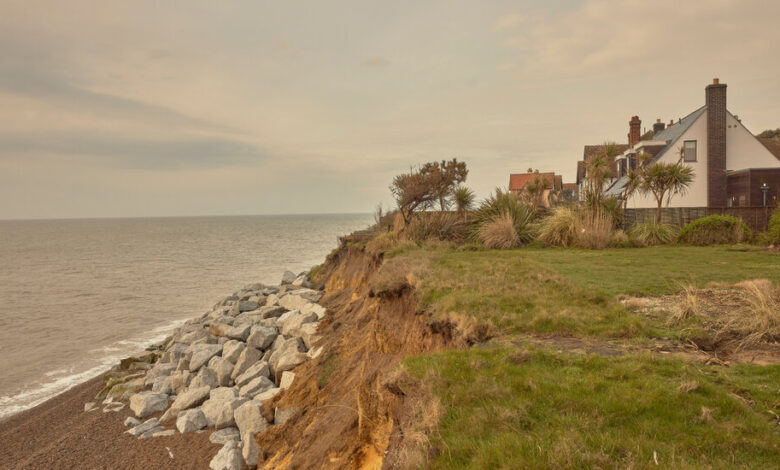In England, Coastal Homeowners Flee as the Sea Swallows Their Towns

[ad_1]
On a stormy day in the spring of 2021, the sea defenses on the beach below Lucy Ansbro’s cliff-top home in Thorpeness, England, washed away. Then, the end of her garden collapsed into the North Sea.
As she watched the plants tumble over the edge, she feared that her house in this coastal village 110 miles northeast of London would be next.
“We lost three and a half meters of land,” said Ms. Ansbro, a 54-year-old television producer, sitting in her kitchen on a recent morning. “Every time I went out, I didn’t know if the house would still be here when I came back.”
Coastal erosion is a natural process as waves pound beaches around the globe, but along this stretch of England’s eastern coastline, stronger storms and bigger waves are striking fear in local residents like never before.
Thousands of homes here are threatened by the sea, and the government agencies tasked with defending them are straining to keep pace. The Committee on Climate Change, an independent body that advises Britain’s Environment Agency, has reported that 8,900 residential properties — 1,200 of which stand on stretches of coastline with no protective structures — are at risk from coastal erosion. Without active shoreline management, around 82,000 homes could be lost by 2105.
To stem the tide, the Environment Agency has pledged 5.2 billion British pounds (around $6.5 billion) to build and realign 2,000 defense structures — including sea walls made from rocks or cement and steel — that could protect communities from erosion and flooding, though not forever.
But in some high-risk coastal communities, homes are being left to the mercy of nature. Distraught homeowners in these areas are facing the prospect of eviction and, worse, of demolishing their own homes.
Ms. Ansbro’s house, which she bought in 2010 for about £590,000, now stands 35 feet from the cliff edge. After she lost her garden, she applied for permission from the local East Suffolk Council and Environment Agency authorities to replace the gabions (metal cages filled with rocks) and the sand-filled geobags that had been lost with riprap. The requests were granted, but that didn’t necessarily mean help was on the way.
In England, the costs of building sea defenses are shared by national and local offices. On the national level, a funding calculator assesses how much of that £5.2 billion budget is potentially available. It depends on whether the “benefits are greater than the costs,” based on a timeline of erosion and four location-specific policy tiers: Advance the Line, where new defenses extend the land area out to sea; Hold the Line, where new defenses maintain the existing shoreline; Managed Realignment, in which the shoreline is allowed to erode but money is spent “to direct it in certain areas”; and No Active Intervention, where no national funds are invested.
On a local level, councils and landowners are left to make up the difference.
“In layperson’s terms, the policies are referred to as defend, retreat or abandon,” said Angela Terry, CEO of One Home, a group advocating on behalf of homeowners at risk.
Aware that the policy for Thorpeness is Managed Realignment, and that the local council’s sea-defense coffers were empty, Ms. Ansbro didn’t expect any support for her house. “I knew that if I didn’t come up with the money myself, I would lose my home,” she said.
So she refinanced her London apartment to pay for the construction of a 1,500-ton granite riprap to fortify the cliff below her property. It cost her almost £450,000, but the house is still standing.
Her next-door neighbors, she said, did not invest in protecting their property, and were forced to vacate the house and then demolish it. “It was a shock to see it go,” Ms. Ansbro said, looking at the spot where the house had stood since the 1920s. “The community feels the government should be stepping in and paying for coastal defenses.”
It’s not always possible. In a statement to The New York Times, an Environment Agency spokesman defended the tiered system of aid for the coastline, saying “Protection measures may not be technically possible or affordable, or may be environmentally damaging.”
Where the coastline cannot be defended, the British government is trying to help communities move back from the sea. Last year, as part of a broader £200 million flood and coast innovation program, £36 million was earmarked to help residents in the two coastal districts with the highest erosion rates in England — East Riding of Yorkshire and North Norfolk — cover demolition costs and relocate.
The five-year pilot program, which is still in a “preparatory phase,” aims “to work with communities on the coast that cannot sustainably be defended from coastal erosion.” But not everyone there is grateful.
In the East Riding of Yorkshire village of Skipsea, Peter Garforth has lived in a brick house overlooking the beach from Green Lane for 23 years. When he bought the place, he felt safe. Despite the lack of sea defenses, there was a road separating the end of his garden from the cliff edge, which was 185 feet away. He was delighted by “the best view in Yorkshire,” he said, and he made improvements to the property, which was built in 1985.
But then the road and a chunk of his garden crumbled into the sea during a cliff fall in 2009. It fell to Jane Evison, an East Riding of Yorkshire councilor, to explain to Mr. Garforth the government’s No Active Intervention policy. “It was a hard message to deliver,” Ms. Evison said. “Most people genuinely thought they would have their homes for the rest of their lives.”
The road was never repaired, and the cliff is now approaching the minimum permissible distance from occupied homes, which is 9.36 meters. Thanks to the new pilot program in his area, Mr. Garforth, 78, qualifies for assistance that could help him finally move inland. But he wants full funding for improved sea defenses to protect his community.
“We feel we are second-class citizens, not as deserving as others,” Mr. Garforth said. “Somehow the appetite to protect the coastline has been lost.”
Most of the remaining properties on Green Lane are now abandoned and vandalized. Some were sold for nearly nothing in cash deals since banks won’t give mortgages for at-risk properties. Nor do insurance companies offer cover.
Still, the East Riding of Yorkshire Council is keeping a close eye on the homes lining the beach. Every six months, aerial surveillance teams measure the distance between the porches at the front of the Green Lane properties and the cliff edge.
“We don’t want a property going over the edge with anyone in it or anyone on the beach at the time,” said Richard Jackson, the council’s coastal change manager.
Mr. Garforth is angry that the nearby hamlet of Mappleton is protected — by two sea walls and a revetment — while his village is not. But there is a reason: Route B1242, the main coastal road in the area, runs directly through Mappleton, warranting the hamlet’s Hold the Line status.
There are other reasons for not erecting defenses along much of the coastline. Some are environmental. “The erosion sediment in East Riding is important for Lincolnshire flood risk defenses,” Mr. Jackson said, referring to the county just south. And of course, “Coastal defenses are expensive,” he said, noting that building a riprap can cost £10,000 per meter.
Mr. Garforth expects to have to vacate his home soon, and when that time comes, he aims to fight it. “When an eviction notice is slapped on my door, I’m taking it to the courts,” he said.
Two hundred miles south in Hemsby, the shoreline has been allowed to erode in keeping with the Managed Realignment policy. In March, five homes were demolished after storms battered the cliffs.
Noel Galer, a Great Yarmouth Borough councilor for Hemsby, said that permission was recently granted for a 0.8-mile rock wall. But paying for it won’t be easy. The national funding calculator uses a formula based on the value of the homes at risk from erosion over the next 25 years. “With the value of these homes being low, the Environment Agency may provide £2 million,” he said.
The council will have to come up with the rest. “We are now in the fund-raising stage,” Mr. Galer said.
Coastal erosion has claimed English communities like Hemsby for centuries. A seat was even removed from Parliament in the 19th century after half the borough of Dunwich was lost to the North Sea. The eastern cliffs are composed of soft clay and gravel, and “if the clay gets wet, that makes it softer, so it erodes,” said Stuart McLelland, co-director of the Energy and Environment Institute at the University of Hull.
Climate change is magnifying the risks for homeowners, as “rising sea levels make beaches smaller and an increase in storminess causes bigger waves,” Dr. McLelland said.
Many coastal residents are selling their homes while they can. A recent search on Britain’s largest property portal, Zoopla, found 81 properties for sale in Hemsby village. Prices range from £26,000 for a two-bedroom bungalow to £600,000 for a five-bedroom villa.
The properties are mostly “cash buys only,” said Bradley Stark, a senior property consultant at Minors & Brady Estate Agents, which is listing two at-risk properties in Hemsby.
“We try not to put clients off, but we do have to give honest feedback about the area,” said Mr. Stark, whose firm sold a two-bedroom home, a mile down the coast from Hemsby, for £300,000 in cash last month.
Ms. Evison, the East Riding councilor, warned that people there who bought coastal properties after 2009 will not be eligible for assistance under the new pilot program. Still, for some house hunters, a property atop an unstable cliff can seem an attractive option — at the right price.
Last October, Helen Vine jumped at the chance to buy the Sellwood Arms pub, which sits near the cliffs in the village of Aldbrough, 12 miles south of Mr. Garforth’s home and subject to the same No Active Intervention policy. The pub is only about 215 feet from where the main road collapsed into the sea six years ago. With beamed ceilings and a four-bedroom apartment on the first floor, where Ms. Vine, 51, now lives with her family, the pub was a bargain at just over £100,000. Sepia photos of village landmarks lost to the sea over the decades hang on the walls. But she remains undaunted.
“There’s no way I would have been able to afford a place like this anywhere else,” she said.
Ms. Vine is renovating the rooms upstairs, without, she joked, going overboard on expenses. The plan is to recoup her investment, and maybe some more, before she is forced to demolish — hopefully not in the next couple of decades.
“It’s a risk,” she said.
[ad_2]
Source link






